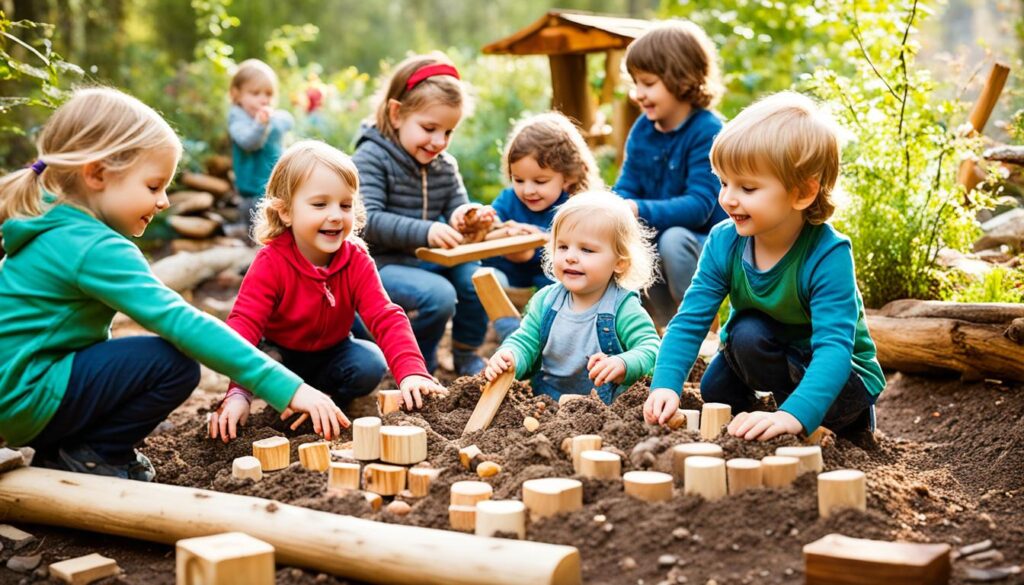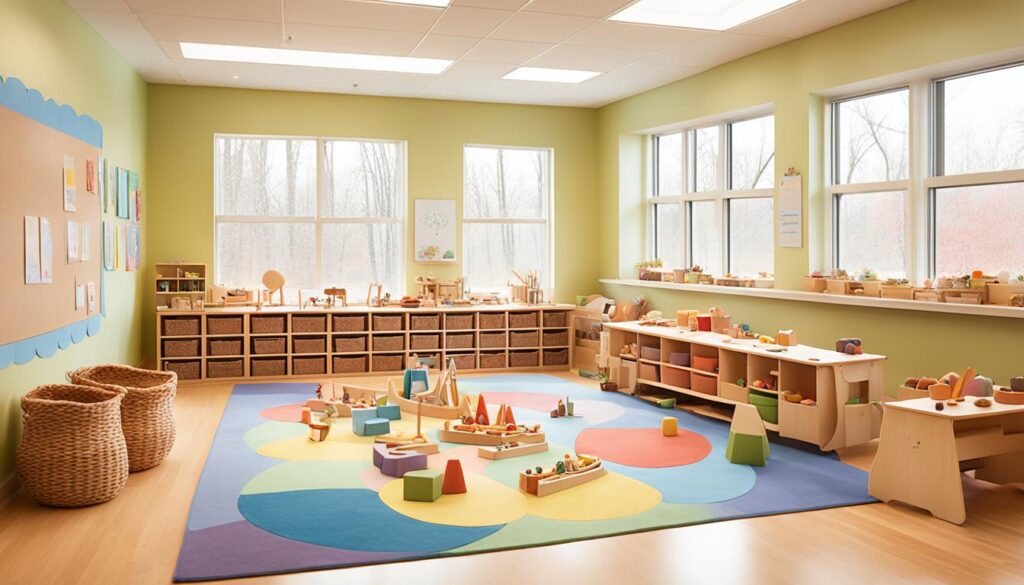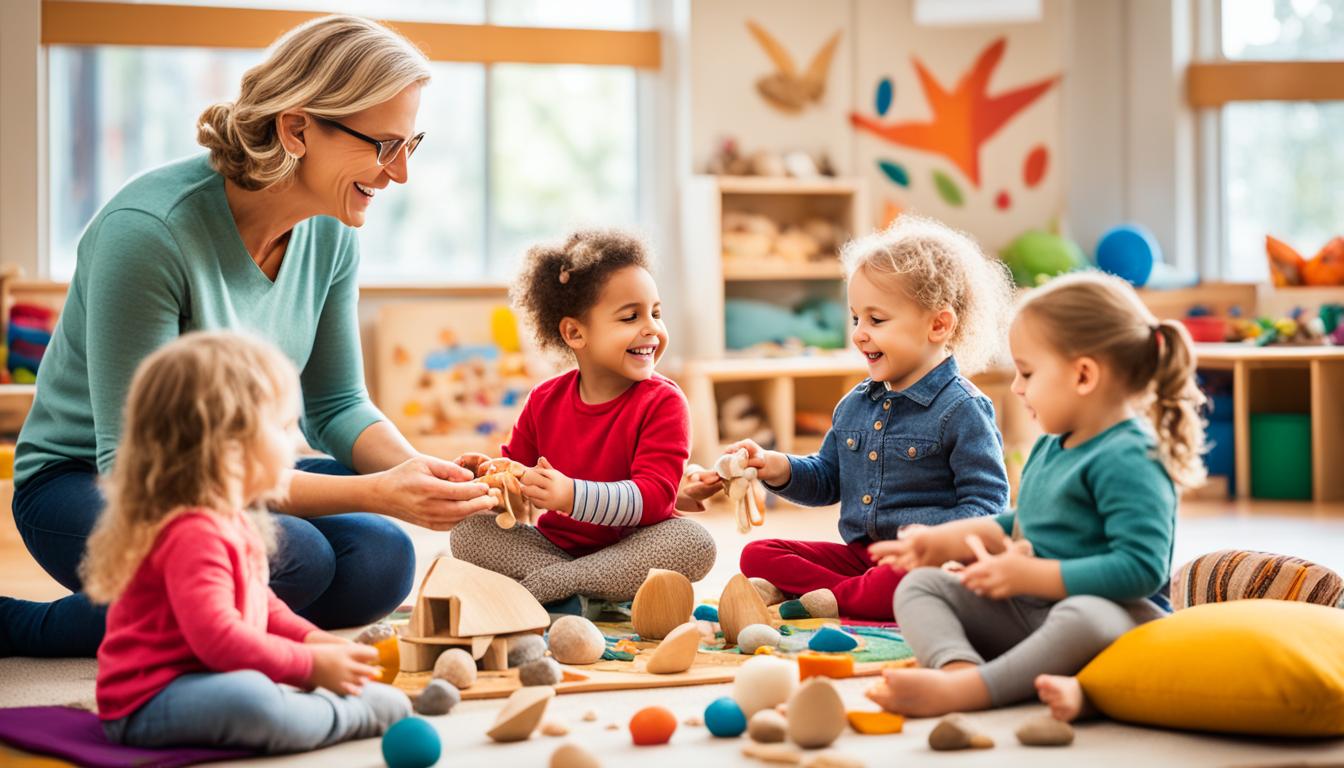Did you know that over 1,000 Waldorf schools exist worldwide, helping more than 300,000 students? This unique way of teaching young kids has won over parents and teachers. It offers a caring and complete setting for kids to grow. The method, based on philosopher Rudolf Steiner’s ideas, values the natural growth stages of children. It focuses on play, using all senses, and hands-on activities.
The core of Waldorf education is valuing the whole child. It sees how the body, mind, and spirit work together in growth and learning. Waldorf teachers create a classroom that feels like nature, aiming to spark wonder, curiosity, and connection. This helps build a strong base for learning and growing throughout life.
Key Takeaways
- Waldorf education focuses on the full growth of the child, caring for the mind, body, and spirit.
- The curriculum matches the natural stages of childhood, promoting learning through doing and experiencing.
- Waldorf classrooms value play, using all senses, and respect for nature and its rhythms.
- This method boosts creativity, imagination, and a strong bond with nature.
- Waldorf education is global, with over 1,000 schools serving more than 300,000 students worldwide.
Waldorf Pedagogy: A Holistic Approach to Child Development
The Waldorf method of early learning is deeply rooted in understanding child growth. It takes a holistic view, focusing on the whole child – body, feelings, and mind.
Nurturing the Whole Child
Waldorf teachers see children as full of potential. They aim to support this potential at every step of their growth. They create learning spaces that engage the senses, promoting hands-on discovery and real-life learning. This way, children grow curious, creative, and love to learn.
Respecting the Stages of Childhood
Waldorf education values each stage of childhood. Teachers know that every phase has its own needs and ways of learning. They adapt their teaching to match the child’s age and growth stage. This ensures kids get the right support to do well.
“The education of even a small child, therefore, does not aim at preparing him for school, but for life.” – Rudolf Steiner, founder of Waldorf education
The Waldorf way shows how important a holistic approach is for child development. It helps children grow and become their best selves.
Play-Based and Experiential Learning
Waldorf Early Childhood Education values the strength of play-based learning and hands-on experiences. Kids do best when they play freely with natural materials. This helps them grow and learn.
Play-based learning helps kids understand the world. They get to explore, experiment, and solve problems on their own. This way, they become creative, solve problems, and connect with nature.
Experiential education is key in Waldorf schools. Kids learn by doing, using all their senses. They might bake bread, weave, or take care of a garden. This way, they learn by experiencing and making things.

Waldorf schools use natural materials a lot. Kids play with wooden toys and beeswax crayons. These things help them play creatively and appreciate nature. It’s a way to learn through touch and sight.
Waldorf education focuses on play, real experiences, and natural materials. It helps kids grow in all areas: thinking, feeling, and being with others. It’s a full way of learning.
Waldorf Early Childhood Education: An Overview
Waldorf early childhood education values the natural growth of a child’s senses and imagination. It focuses on sensory integration and natural materials. These elements help develop the whole child.
Sensory Integration and Natural Materials
Waldorf classrooms offer a rich sensory experience. They use natural materials like wood, wool, and beeswax instead of synthetic toys or media. These materials help with sensory integration. They let children fully experience their world and support their growth in all areas.
Rhythm and Routine in the Waldorf Classroom
The Waldorf method also stresses rhythm and routine. The classroom has a daily schedule that gives children security. It includes active play, creative time, and quiet moments. These activities help children learn naturally.
By using sensory integration, natural materials, and a structured schedule, Waldorf education helps the whole child. It supports their growth in thinking, feeling, and social skills in a balanced way.

“The best way to prepare children for the future is to give them the best of the present.” – Maria Montessori
Imaginative Play and Creativity
Waldorf Early Childhood Education values the key role of imaginative play and creativity in a child’s growth. It sees creating a space for open-ended play as crucial for a child’s happiness and self-expression.
Encouraging Creativity and Self-Expression
Waldorf classrooms are places where creativity blooms. Kids get to explore, find, and show who they are through various activities. They build with natural materials and act out stories, letting their imaginations run wild.
Open-ended toys like wooden blocks, dolls, and costumes boost imaginative play and creativity. These toys let kids tell their own stories and create their worlds. This helps them express themselves and love learning.
“Imaginative play is the work of childhood, and it is through this play that children develop the qualities and capacities they will need as adults.”
Waldorf teachers believe in sparking a child’s wonder and curiosity. This sets the stage for a life of discovery and growth. Through imaginative play and creativity, Waldorf students learn to share their unique voices and succeed in the world.
Conclusion
Waldorf Early Childhood Education offers a special way to help children grow. It focuses on play, rhythm, and connecting with nature. This approach respects childhood stages, letting kids learn at their own speed.
Waldorf schools boost creativity and imagination. They help kids grow in body, heart, and mind. The use of natural materials and sensory experiences makes learning fun and engaging. This helps kids stay healthy and ready for the future.
Parents and teachers see Waldorf Education as a top choice for kids. It cares for the whole child and values each stage of growth. With its focus on the whole child and nature, Waldorf education is a guiding light for those who see great potential in every child.
FAQ
What is Waldorf Early Childhood Education?
Waldorf Early Childhood Education focuses on the whole child. It covers physical, emotional, and cognitive growth. The method uses play, natural materials, and a structured routine in the classroom.
How does Waldorf pedagogy differ from traditional educational approaches?
Waldorf education focuses on the child’s growth in a holistic way. It doesn’t stress grades or tests. Instead, it supports sensory integration, creativity, and well-being through play.
What is the role of play in Waldorf Early Childhood Education?
Play is key in Waldorf education. It helps children be creative, solve problems, and understand the world. Open-ended play with natural materials is encouraged.
How does Waldorf education integrate the senses and natural materials?
Sensory integration and natural materials are key in Waldorf education. Kids learn by doing, using materials like wood and wool. This helps them understand the world better.
What is the role of rhythm and routine in Waldorf classrooms?
Rhythm and routine are vital in Waldorf schools. Teachers create a secure environment with a daily and weekly schedule. This helps children grow naturally through repetition.
How does Waldorf education encourage creativity and self-expression?
Waldorf education values creativity and self-expression in young children. It uses imaginative play and open materials. This helps kids explore, create, and express themselves freely.
